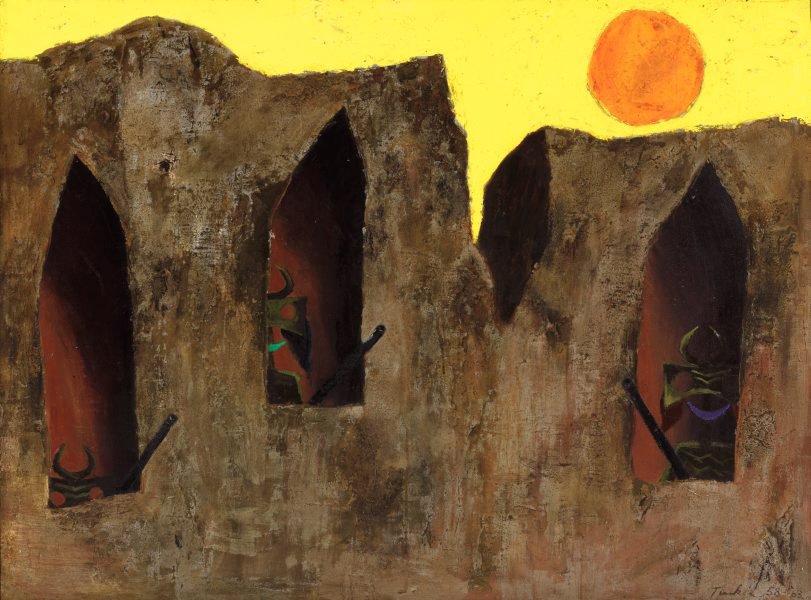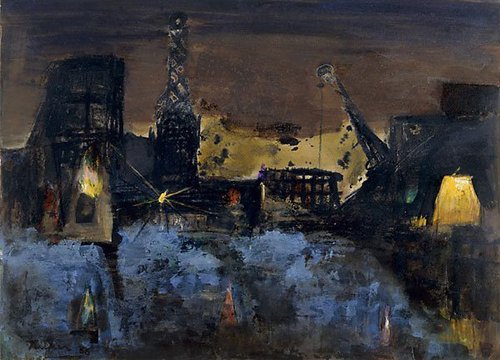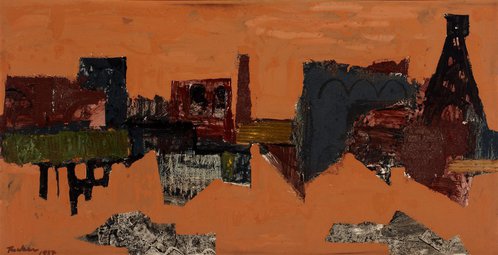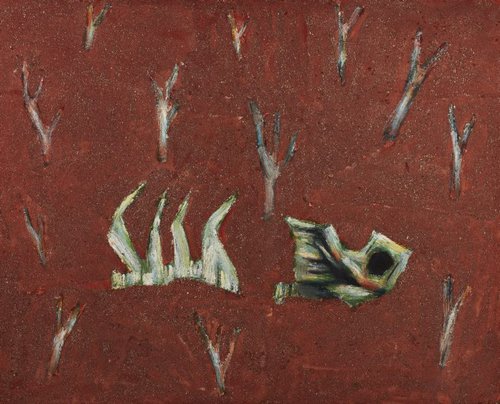-
Details
- Date
- 1958-1963
- Media category
- Painting
- Materials used
- synthetic polymer paint on hardboard
- Dimensions
- 95.8 x 130.0 cm board; 110.5 x 143.8 x 4.0 cm frame
- Signature & date
Signed and dated l.r.corner, black synthetic polymer paint "Tucker 58-63".
- Credit
- Gift of the Albert & Barbara Tucker Foundation 2017
- Location
- Not on display
- Accession number
- 199.2017
- Copyright
- © Albert & Barbara Tucker Foundation. Courtesy of Smith & Singer Fine Art
- Artist information
-
 Albert Tucker
Albert Tucker
Works in the collection
- Share
-
-
About
Albert Tucker, one of Australia’s most important post-war artists, helped reinvigorate and re-mythologise the Australian landscape through his modernist approach. Along with Sidney Nolan, Joy Hester, John Perceval and Arthur Boyd, he was part of the group of artists active at Heide, near Melbourne, in the 1940s and enjoyed the patronage of John and Sunday Reed. Tucker left Australia in 1947 and spent the next thirteen years travelling and painitng in Japan, England, Europe and the United States.
As an expatriate artist living in Italy in the 1950s, Albert Tucker began to explore the ideas and imagery of the Australian landscape and mythology. ‘I was having nostalgic memories of Australia. I was remembering the dryness and gum tree trunks… I had that sense of dried out cratered form which were also volcanic landscapes, and they could also be wounds and gashes.’
In Rome Tucker met the acclaimed arte povera artist Alberto Burri, whose use of PVA and mixed media to build up his paint surfaces inspired Tucker to adopt the approach. The built-up surfaces he achieved with PVA, sand and other materials incorporated with paint are a noted characteristic of his work and realistically depict the ‘gashes and wounds’ of the harsh Australian landscape.
‘Bushrangers’ demonstrates Tucker's interest in the Australian mythology surrounding the bushragers and explorers of the country’s past, a fascination he shared with his friend Sidney Nolan. Much in the way Nolan’s black Kelly helmet became his hallmark, Tucker’s ‘Antipodean head’ became his. This distinctive profile head with its rough, cratered surface is used in many of his works and he continued to experiment with and alter the head shape throughout his career.
In the 1950s and 60s Tucker was determined to show Australians the forms and shapes of the country through both his paint treatment and subject matter. His handling of the themes of Australia’s people and land brought a fresh approach to painting in this country and contributed to the myth-making of Australia’s folk heroes and its unique and strange wildlife, all powered by his affection for the native landscape.
-
Exhibition history
Shown in 3 exhibitions
Albert Tucker (1969), Bonython Art Gallery [Sydney], Paddington, 28 Oct 1969–19 Nov 1969
Albert Tucker: Paintings 1945-1960, Tolarno Galleries, Melbourne, 1982–1982
Albert Tucker: promised gifts from the Estate, Art Gallery of New South Wales, Sydney, 17 Jan 2007–11 Mar 2007
-
Bibliography
Referenced in 7 publications
-
Bonython Art Gallery [Sydney], Albert Tucker, Sydney, 1969. cat.no. 59; titled 'Bushrangers'; not paginated
-
Edmund Capon AM, OBE, Foundation Newsletter #8, Sydney, Jun 2006. not paginated
-
Gavin Fry, Albert Tucker, Sydney, 2006, 151 (colour illus.). dated 1958-1963
-
Barry Pearce, Look, 'Albert Tucker: A chance for Sydney to get to know a Melbourne artist better', pg. 12, Sydney, Mar 2007, 12.
-
John Saxby (Editor), Look, Sydney, Mar 2018-Apr 2018, 28-29 (colour illus.).
-
Albert Tucker, Richard Haese and Tolarno Galleries, Albert Tucker: paintings 1945-1960, Melbourne, 1982, (colour illus.). not paginated; cat.no. 57; dated 1963
-
Christopher Uhl, Albert Tucker, Melbourne, 1969, 71 (colour illus.). plate 25; cat.no. 10.36; dated 1958-1960
-




